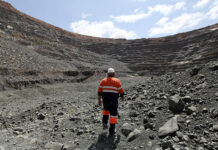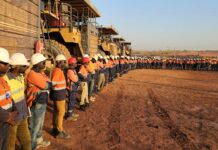
[miningmx.com] – SOME analysts are getting behind the Anglo American restructuring story believing that this time real improvements in the UK group’s performance are in the offing.
“We consider Anglo an attractive restructuring story that should ultimately reward investors as CEO, Mark Cutifani works to unlock value from the company’s resource base,’ said Macquarie Research analysts, Jeff Largey and Kieran Daly.
The market tends to agree. Shares in Anglo American are up 40% over the last 12 months – 30% since the beginning of the year – which is way better than the 17% and 18% one-year return in the shares of Rio Tinto and BHP Billiton respectively.
Ever since it listed in London in the Nineties, Anglo American has been a company undergoing massive transition from the apartheid behemoth to the eminently more nimble company it is today; although, not nimble enough it seems.
Trailing its peers BHP Billiton, Rio Tinto and Glencore, Anglo has always been down the pecking order when it comes to share ratings.
Anglo CEO, Mark Cutifani, who took up the reins at Anglo in April 2013, promised yet more streamlining of the portfolio with the recent platinum industry strike only hastening the restructuring of the group’s Rustenburg mines in Anglo American Platinum (Amplats), which will most likely result in an outright sale.
According to one analyst, the sale of the platinum assets alone would add about 27% to Anglo’s return on capital employed (ROCE), the metric that Cutifani has pledged to address first and foremost identifying a 15% return by 2016 which would require a doubling in 2012’s pre-tax profits to $7.3bn.
The recent rise in the price of nickel, owing to a ban on exports from the metal’s largest producer, Indonesia, also raises the chance that Anglo will dispose of its Barro Alto assets which it wrote-down in February for $700m, and that Cutifani said he might sell.
“It’s a good time to buy the assets when the majors think it’s not stratetic and into a rising price environment that generates the cash you’ll need to invest in the project,’ said Paul Gait, an analyst for Sanford C. Bernstein.
Earlier this month, the group announced plans to sell its 50% stake in the Lafarge Tarmac joint venture which is expected to generate $1.5bn, funds it said it would pump into reducing debt.
Outside of restructuring and asset sales of unprofitable mines, however, there are a few other reasons to be cheerful of Anglo American’s prospects under Cutifani. One is the commissioning of its Brazil iron ore project, Minas Rio.
Anglo American heavily overspent on Minas Rio having trailed its peers in finding iron ore production to satisfy Chinese industrialisation. In January 2013, Anglo impaired Minas Rio by $4bn and set aside another $600m for contingencies.
It was a heavy blow to then CEO Cynthia Carroll – a turn of events many believed signalled the end of Carroll’s time at Anglo.
Minas Rio will have absorbed about $8.8bn in capital amid extensive delays and budget overruns. A new deadline for the mine was set for December which analysts believe Anglo will meet.
If it does so, it will signal the end of the group’s high capital expenditure phase not to mention the fact that the mine will start generating much needed cash flow.
Anglo has guided the market towards net debt of between $14bn to $15bn against liquidity of $18bn, but the intention is to take the debt figure in the medium term down to $10bn to $12bn, a goal that production from Minas Rio, as well as the commissioning of the Grosvenor coal project in western Australia can assist in doing.
Said an analyst: “We think that the conversation between investors and management will now shift from identifying the problems and plans to delivery and that this is the next stage for Anglo, starting with Minas Rio and platinum’.
There are, of course, the cynics.
A UK analyst recently expressed the view that shares in Anglo American were rising because the group’s CEO, Mark Cutifani, was speaking to investors who “hadn’t heard the story before’.
The implication was that the promised turnaround in fortunes at South Africa’s best known mining company has been an iterative investment theme, but much like the country’s national soccer team, it always ends in disappointment.










